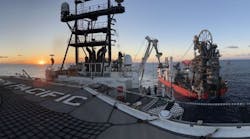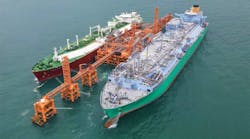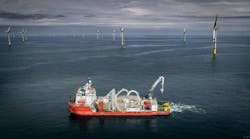The Millom West platform in UK Block 113/26a in the Morecambe area of the Irish Sea was installed earlier this year, but it wasn't without significant change in the base of the production structure at nearly the last moment. The structure was installed by the Joint Venture Group, consisting of Consafe Engineering, Genesis Oil and Gas Consultants, and Stolt Offshore. Water depth at the site is 35 meters.
The gas field is owned by Burlington Res-ources (Irish Sea) and will be operated by Hydrocarbon Resources Limited. In the early part of this year, it became apparent that the project was facing a schedule delay on the fabrication of the originally planned concrete gravity base. Moreover, cyclic test results had shown that the foundations for the concrete gravity base could become unstable under cyclic loading conditions.
At the site, the seabed consists of medium to dense sands with a very loose top layer 3.5 meters thick. Following review of several alternatives, it was decided to replace the gravity base with suction piles as a foundation.
Suction Pile Technology (SPT) was awarded the contract by Genesis Oil and Gas Consultants for the design and installation of the suction pile foundation and the verification of the marine installation engineering. SPT was already involved with Genesis in a study for the Calder development using suction piles.
The installed platform is a four-leg self-installed jackup type platform with a truss deck weighing about 350 tons, including minimal facilities to process the gas. The total weight of the legs and suction piles is about 1,050 tons, with a leg diameter of 1.75 meters and a suction pile diameter of 7 meters and 9.5 meters deep.
Last minute change
While the fabrication of the deck and the four legs was already underway when the decision to change was taken, the use of a suction pile foundation was said to have had a limited impact on the platform design. This was because the resistance of the suction pile foundations against overturning and shear is high, resulting in a restraint close to the original gravity base concept.
The criticality of the schedule meant a fast track design and construct, and demanded that the suction pile design take place in parallel with the fabrication. The platform was fabricated in Consafe Yard, Burntisland, and the final assembly of the leg/suction piles on the deck was done in Barrow. Transportation and installation of the platform was achieved by using a transport barge to tow the platform from Barrow to Millom West. During the lowering of the legs and anchoring operations, the deck was supported on the barge.
The deck was then lifted from the barge into its operating elevation. As each leg/suction pile assembly, weighing approximately 260 tons, penetrated through the very soft top layer into the dense sand layer some 3.5 meters below, the liquefaction problem was avoided and a stable foundation for suction operations was guaranteed. The trapped air within the suction piles formed an essential part of the stability of the platform during tow and installation, according to Mark Riemers, Managing Director of SPT.
During transport, the suction piles protrude through the water plane and contribute to the overall stability of the barge. The stability analyses is complicated as the buckets are open at the underside and contain enclosed air on top of the water within the suction pile. SPT provided the naval architectural experience to take this effect into account, which was validated by performing inclination tests in port.




